If you've ever wondered how the art of embroidery could be expressed through the senses of sight and sound, prepare to be captivated by "Stitch by Stitch," a groundbreaking project by Naima Almajdobah. Naima is a designer with a Bachelor’s degree in Graphic Design and is currently undergoing a Master’s degree in Design Studies at VCUarts Qatar.
However, “Stitch by Stitch” is not merely a showcase of intricate patterns and beautiful textiles; it’s an audio-visual expedition, a pioneer in its fusion of cultural research, pattern creation, and the mesmerizing world of sound. Naima's exploration and interest in design grew from a personal interest in sonic explorations and cultural literacy, and she believes that focusing on her culture and mixing it with contemporary mediums and technologies can preserve that culture, shed light on the lost crafts that once existed, and help other people learn more about them.
What makes Naima's project especially poignant is her deep connection to Palestine, a place she has never set foot in but holds close to her heart. It’s a testament to her unwavering love for a land often overshadowed by tales of conflict and turmoil. These Thobes, adorned with traditional embroidery, stand as a source of immense pride for Palestinians. Originating from a time when Arab farmers formed the majority of the population in Palestine, this unique art form was exclusively cultivated and sustained by peasant women in countless villages across the region.
It’s through this time-honored tradition that Almajdobah seeks to not only shed light on the craft but also to bring it to life through the medium of music.

Marsya Abdulghani: How do you see audio-visual art as a means of preserving cultural heritage, and what unique advantages does it offer compared to other forms of preservation?
Naima Almajdobah: Audio-visual art can capture the dynamic nature of cultural practices, rituals, and performances in ways that static forms of preservation like photographs or written descriptions cannot. It allows for the preservation of movement, music, and spoken language, which are essential aspects of many cultural traditions. It also has the power to engage people emotionally and intellectually. It can bring cultural heritage to life and make it more relatable to a broader audience, fostering a deeper connection and understanding of the culture being represented. It enables wide distribution and easy access to cultural heritage.
With the advent of digital technologies, audio-visual content can be stored, shared, and accessed globally, providing broader and more equitable access to cultural heritage materials. It can offer a multisensory experience, engaging both auditory and visual senses. This immersive quality can enhance the appreciation and understanding of cultural practices, artifacts, and stories.

(M.A.): What kind of reactions or feedback have you received from audiences and how do these reactions reflect on the preservation of culture through art?
(N.A.): The sole purpose of this project was to teach people about this tradition and allow them to see the intricate beauty that lies in this visual system, while also adding to it with a new and contemporary twist that would make it appealing to kids of this generation to ensure its continuation. All the reactions I got were amazing, from shock, to surprise to amazement. A lot of the feedback that I got was about how this project was unique and different, making it so special and unique in the design world, because this project was able to show the vast spectrum of graphic design, and how graphic design is more than just brand identities and logos.
With this project I got accepted to the top design master programs in the world like, RISD, DAE, and OCAD. This project was then selected to represent VCUarts Qatar during the “I am QF” event that took place 2 years ago with the presence of Sheikha Hind Bint Hamad Al-Thani. It was chosen to be part of multiple worldwide exhibitions like, Foreword in Singapore, Ithra in KSA, Bangkok Design Week in Thailand, ARS Electronica in Austria, and very recently in Festival X in UAE. My dream and goal was to have this project travel the world, to allow the people that don’t know about this craft to see it, experience it, and most importantly hear it.
(M.A.): How does audio-visual art contribute to the revival of interest in cultural traditions and practices that may be fading or endangered?
(N.A.): Audio-visual art can document and preserve cultural practices, rituals, and traditions in a visually engaging manner. This documentation serves as a valuable resource for future generations, ensuring that important cultural knowledge is not lost, by creating engaging and informative audio-visual content, cultural traditions can be introduced to a wider audience, including younger generations who may have limited exposure to these practices. This educational aspect can kindle interest and curiosity.

Audio-visual art can be used to tell the stories and histories behind cultural traditions. Narrative elements can draw people into the cultural context, making it more relatable and intriguing. As well as, younger generations, who may be more accustomed to digital media, are often more receptive to audio-visual content. By presenting cultural traditions in a visually appealing way, it can attract the interest of younger individuals and that will result in preserving the fading or endangered traditions.
(M.A.): How do you envision your project being used for educational purposes, such as in schools or cultural institutions, to teach and raise awareness about Palestinian culture and heritage?
(N.A.): Incorporating "Stitch by Stitch" into educational settings can be a powerful way to teach students about the rich and diverse cultural heritage of Palestine, as well as to inspire a broader appreciation for the role of design and music in preserving and celebrating that heritage. There are many ways to do that including that this project provides a multisensory learning experience by combining visual art (embroidery patterns) and auditory elements (music). This approach can engage students on multiple levels, making the learning experience more immersive and memorable. It can be integrated into art and design classes, teaching students about the art of embroidery and the techniques involved. This hands-on approach can foster an appreciation for traditional craftsmanship. While also including a new and fun approach to learning such a time-consuming technique.







